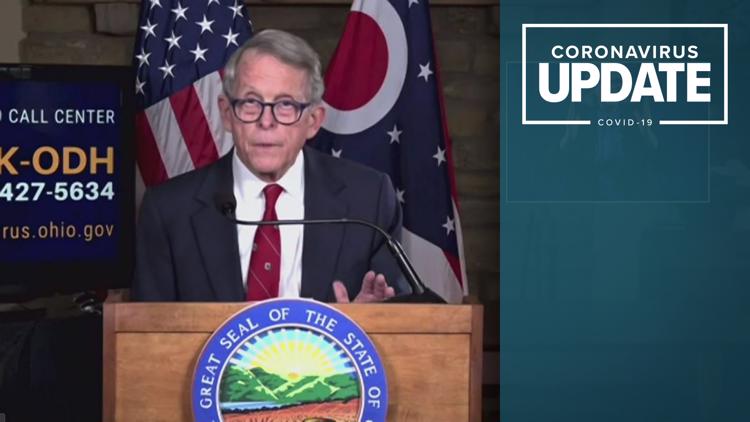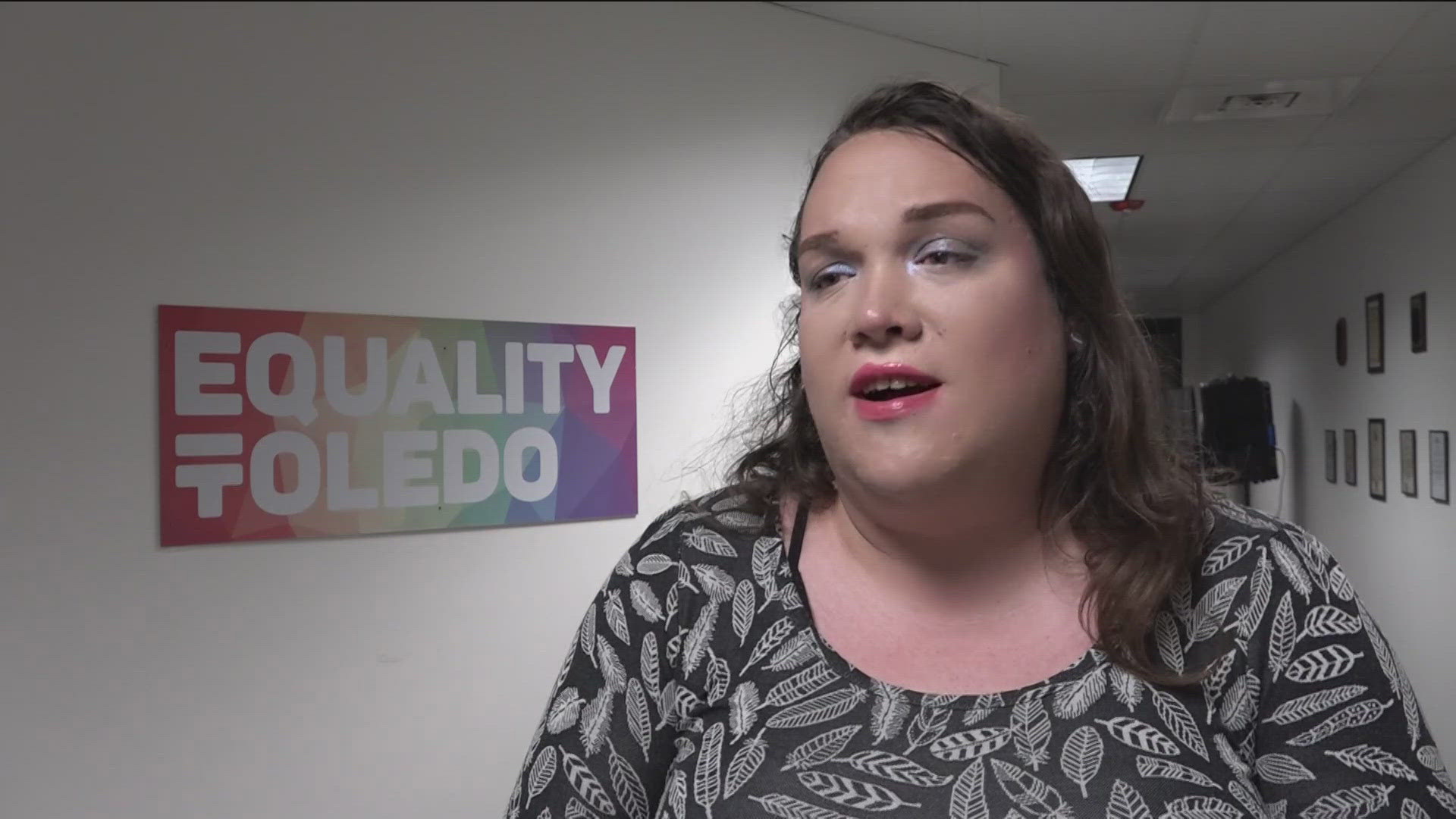COLUMBUS, Ohio — Ohio Gov. Mike DeWine addressed the state Thursday with new information on his response to the coronavirus pandemic.
The governor announced a big increase in vaccine doses on the way from Pfizer and as hospitalizations continue to trend downward, a potential end for the current statewide curfew.
Here is a breakdown of what was discussed.
VACCINATION
DeWine said leaders with Pfizer expect to increase the amount of vaccine available for federal shipment by about 40% around the middle of Feb. The governor said he believes this federal increase should translate to an increase in doses for the state of Ohio around the same time.
Pfizer has also reported that at least by the end of March, vaccine shipments to Ohio should double compared to where the state is now. Currently, Pfizer is shipping 73,000 doses to Ohio each week.
Moderna doses have increased from 73,200 two weeks ago to 105,600 for the state next week. The governor said he believes Moderna vaccine shipments will soon expand as well.
DeWine noted that Ohio is among the top five states for delivering vaccines to long-term care residents, a population that has been a key focus of his administration's vaccination effort.
"This is great news because residents in these facilities are the most vulnerable Ohioans. We're now starting to see what we'd hoped to see: a significant drop in cases," DeWine said.
KEY INDICATORS
On Thursday, the state reached a small milestone, dipping below a 21-day average for daily cases below 5,000 for the first time in months.
However, the other daily indicators have averages that seem to have plateaued, and Thursday's numbers for deaths, hospitalizations and ICU admissions all surpassed their respected averages.
The Ohio Department of Health reported:
- 4,120 new coronavirus cases compared to the 21-day average of 4,931
- 79 new coronavirus-related deaths compared to the 21-day average of 72
- 237 new hospitalizations compared to the 21-day average of 220
- 34 new ICU compared to the 21-day average of 24

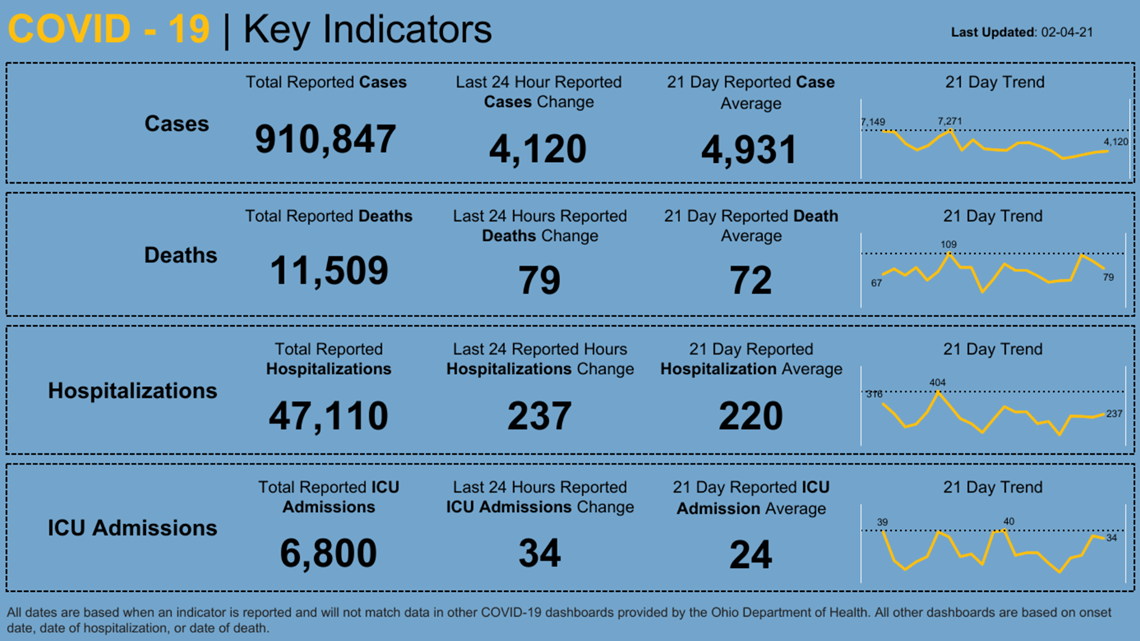
HOSPITALIZATIONS AND THE FUTURE OF THE STATEWIDE CURFEW
On Thursday, there were 2,252 COVID-19 positive patients in Ohio's hospitals.

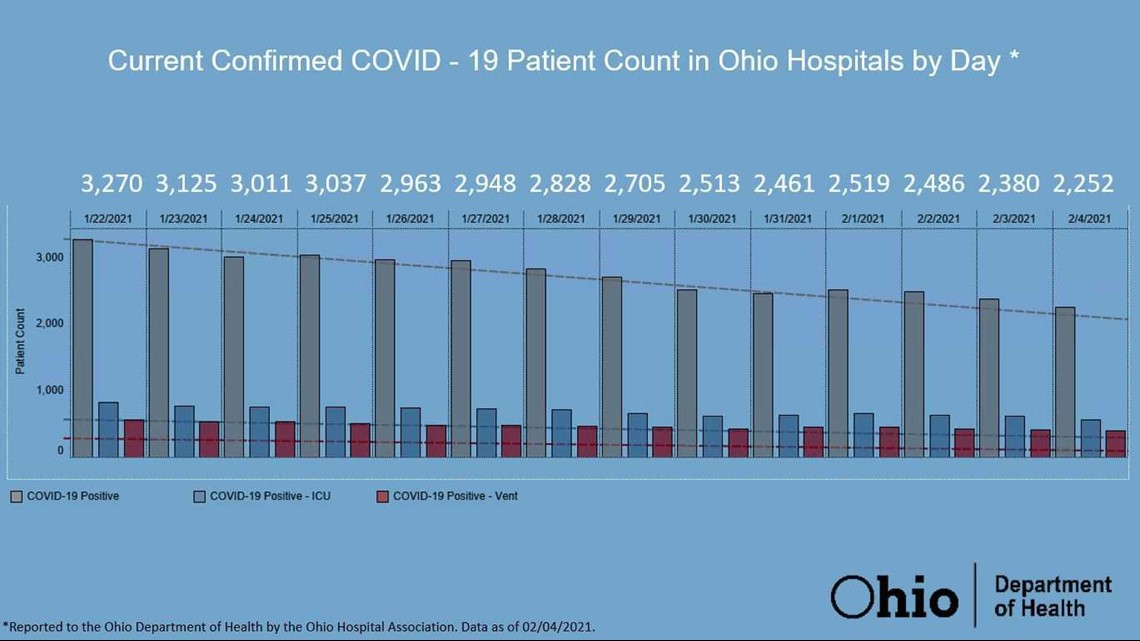
Last week, DeWine pushed the start time for the statewide coronavirus curfew to 11 p.m. for a period of at least two weeks after hospitalizations dropped below 3,500.
From there, he said if hospitalizations dropped below 3,000 for seven straight days the curfew could be moved to midnight and if they dropped below 2,500 for a week, the curfew would be dropped.
Thursday marked the third consecutive day the state saw less than 2,500 hospitalizations. If the current trend continues, DeWine said the curfew could be lifted next Thursday.
However, he noted that the virus is "unpredictable." If numbers were to again increase, the curfew would likely continue.
"This virus has taught us that it just has a mind of its own. We don't know what it is going to do. But for today, that is certainly good news," DeWine said.
UNEMPLOYMENT
DeWine said Ohioans are starting to see the new federal money they are due and claimed those who haven't yet, will soon.
So far this week, the state has reportedly paid out nearly $100 million to more than 110,000 Ohioans receiving traditional unemployment, representing some extended weeks of benefits plus an additional $300 a week, which were included with the new federal aid.
Starting this Saturday, DeWine said more than 155,000 Ohioans will also start seeing benefits from this new federal aid package, including new people who recently lost a job as a result of the pandemic as well as Ohioans who continue to be impacted by the pandemic.
By the last week in February, DeWine said everyone will have the ability to claim all the weeks and supplements available under the law and receive the benefits they are owed.
COMPLETE PRESS CONFERENCE
TUESDAY
VACCINE STORAGE ISSUE IN FIVE OHIO NURSING HOMES
Some vaccines given by Walgreens in five long-term care facilities on Monday were not stored under the proper cold storage conditions, DeWine said.
Ohio Department of Health (ODH) Chief Medical Officer Dr. Bruce Vanderhoff said that while no harm has been done, the individuals impacted will need to be revaccinated.
"This is not an issue though of any known harm being done," he said Tuesday.
Vanderhoff also noted that not all doses distributed at these facilities Monday were compromised.
The breached doses were distributed at the following facilities:
- Ashtabula County Residential Services Corp. "The Maples" in Kingsville
- Ashtabula Towers in Ashtabula
- Heather Hill Care Communities in Chardon
- Six Chimneys on East Cleveland
- Willow Park Convalescent Home in Cleveland
Vanderhoff said that Walgreens identified the storage issue through its quality control processes. Representatives immediately reached out to the Centers for Disease Control and Prevention (CDC) and the vaccine's manufacturer to work toward next steps.
Walgreens will work with the CDC and the affected nursing homes to determine which patients may need to be revaccinated. Once they are identified, both organizations will work to ensure these patients get their new vaccine at the right time.
Patients at these facilities do not need to do anything, Vanderhoff said, they will be contacted if necessary.
Vanderhoff explained that mRNA vaccines are "remarkably safe and effective," but can be challenging to handle as they require ultracold storage until they are ready to be administered.
There are 920 skilled nursing facilities in Ohio. DeWine said Tuesday the state has distributed the first dose of the vaccine in all of these facilities and have given the second dose in 89%.
The state has 645 assisted living facilities with first doses out in 86% of these facilities and second doses at 48%.
DeWine noted his team has a plan in place to continue vaccinating in both the state's nursing homes and assisted living facilities as new residents move in.
ADDRESSING HEALTHCARE INEQUITY
DeWine noted that the pandemic has highlighted inequities in the state's healthcare system.
"There are Ohioans who simply do not have equal access to healthcare. We've worked to address these gaps, especially in our efforts to roll out the vaccine, but it's a work in progress. There is more to do," the governor said Tuesday.
DeWine said that when his team created their plan to distribute the coronavirus vaccine, they intentionally made sure there were locations in every county in the state. He explained that his administration recruited a network of providers to make sure that Ohioans had access no matter where they lived.
This week, 700 providers are involved in the distribution process.
DeWine said that while it would have been simpler to set up a few "mega-sites," his team ultimately decided they wanted a vaccine location in every community.
"Some states have had bigger vaccination sites but in fewer locations. We recruited a network of providers so that Ohioans would have access to vaccine close to home," DeWine said.
The administration is utilizing federally-qualified health centers, which serve vulnerable communities across the state. More than 60 of these centers will be receiving the vaccine this week.
DeWine said he is also working with these centers, along with faith-based communities and local health departments to set up pop-up vaccination sites in some of Ohio's at-risk communities.
ODH and Ohio Medicaid are working together to provide options for transportation to eliminate even more barriers for those who are seeking vaccination.
VIRTUAL TOWN HALLS
DeWine said that following feedback from the state's Minority Health Vaccine Advisory Group the state will work to gain a better understanding of the barriers to vaccination and help develop solutions.
One effort from the state, is the launch of a series of virtual town halls.
These will begin live-streaming the week of Feb. 22, DeWine said. You can find more information on how to participate in these events on the state's coronavirus website here.
Next week, the governor also said there will be six vaccine events in senior affordable housing complexes.
WHO IS ELIGIBLE FOR THE VACCINE RIGHT NOW?
Currently in Ohio, here is who qualifies for the coronavirus vaccine:
- Those 70 and older
- Teachers and school personnel necessary for in-person learning
- Those with severe congenital, developmental or early-onset medical conditions and who have an intellectual or developmental disability

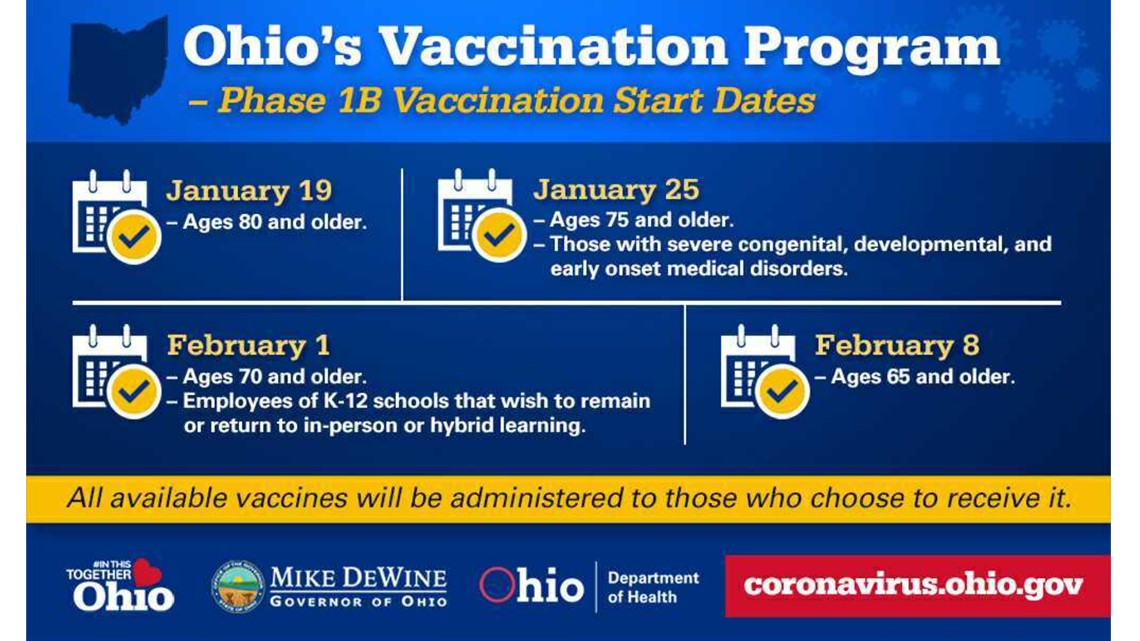
Next week, Ohioans 65 and older will qualify. After that, the state will pause in order to catch up vaccinating all of those who are eligible under Phase 1B. In total, it is estimated that 2.2 million Ohioans fall into this group.
KEY INDICATORS
On Tuesday, the Ohio Department of Health (ODH) reported:
- 3,657 new cases of coronavirus compared to the 21-day average of 5,228
- 106 new coronavirus-related deaths compared to the 21-day average of 73
- 221 new hospitalizations compared to the 21-day average of 228
- 21 new ICU admissions compared to the 21-day average of 23

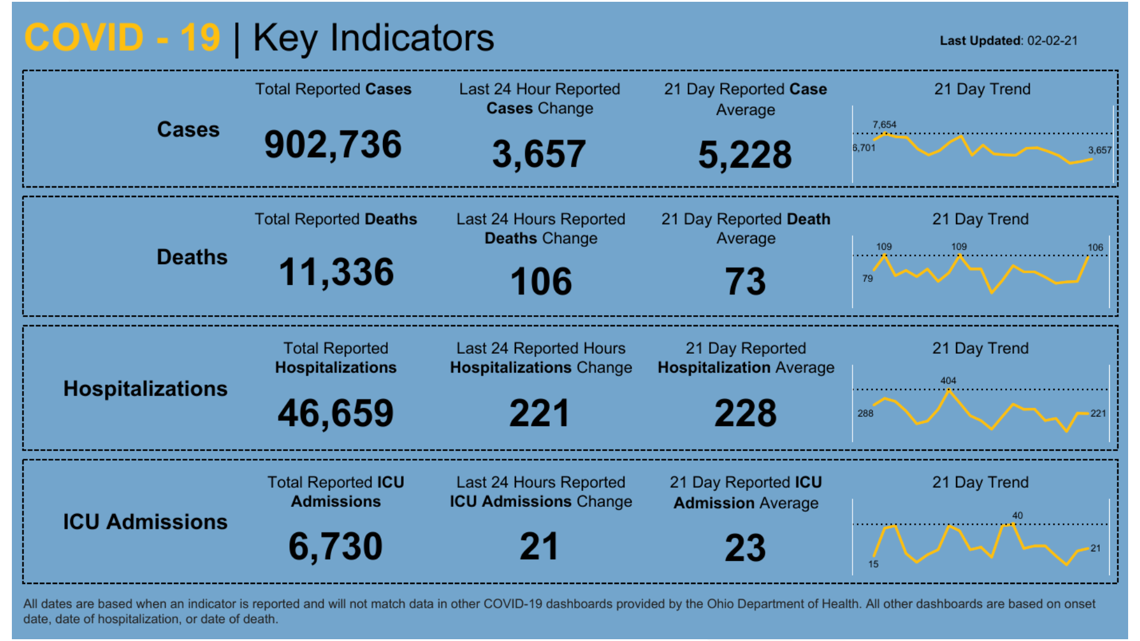
HOSPITAL UTILIZATION

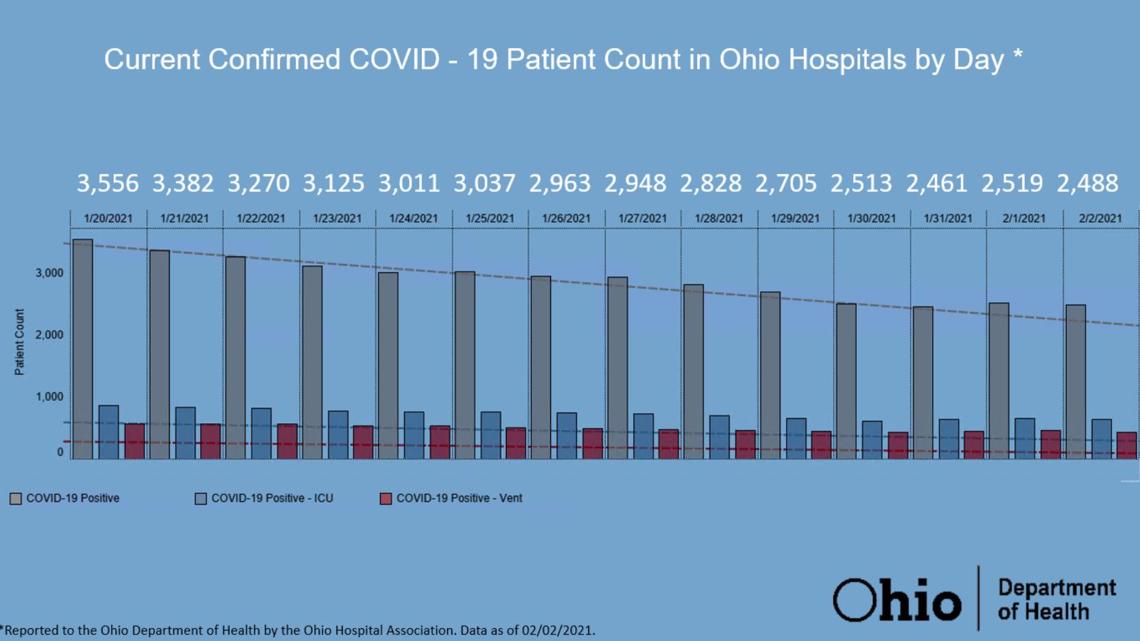
As a reminder, here are the criteria put forth by the governor regarding the state's coronavirus curfew:
- If hospitalizations drop below 3,000 for seven consecutive days, the state will move to a midnight curfew for at least two weeks.
- If hospitalizations drop below 2,500 for seven consecutive days, state leaders will drop the curfew.
It should be noted, however, that if these numbers go up again, the curfew could return to a 10 p.m. start time or be reinstituted if it is eventually removed.


